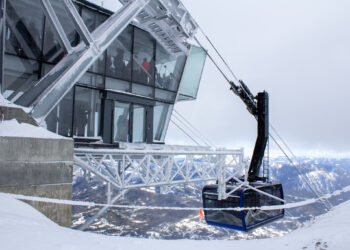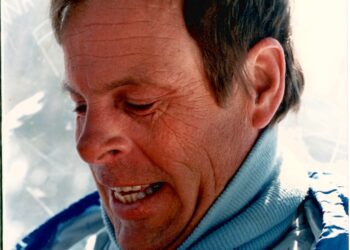
By Todd Wilkinson EBS Environmental Columnist
When Montana hunter Todd John Orr was attacked twice by a grizzly bear on Oct. 1, the mauling, thanks to social media and the victim carrying a video camera, captured instant attention from around the world.
To date, more than 39 million people have viewed footage of the bloodied sportsman from Bozeman via Facebook and YouTube. Many people are astonished how a badly wounded Orr, after walking three miles out of the backcountry, had the wherewithal and composure to interview himself before seeking medical attention.
One of those who saw the video, Chuck Bartlebaugh, became gravely concerned about the message being communicated to the masses as news of the incident circulated virally, accompanied by media reports which were, in some cases, sensationalistic.
Bartlebaugh, founder of a campaign called Be Bear Aware, specializing in educating the public about using bear spray, decided to turn gumshoe detective of sorts. He interviewed the 50-year-old Orr seeking answers to a pair of key questions: Did the bear spray Orr carried with him work? And why did the grizzly attack him twice?
This week, Bartlebaugh released his findings, a week after he presented them to Gregg Losinski, chairman of the Interagency Grizzly Bear Committee at its annual year-end meeting in Missoula, Montana.
The basic facts are these: In early October, Orr had been hiking solo, scouting for elk, in the North Fork of Bear Creek on the western face of the Madison mountains in southwest Montana. Figuring grizzlies were probably in the area, he told Bartlebaugh that he had shouted “Hey bear!” to let his presence be known. Then, seemingly out of nowhere, an agitated sow grizzly about 80 yards away stood up and charged.
The mother with cubs disappeared momentarily in trees before the protective adult bruin reemerged 50 yards away bearing down on Orr. The hunter was carrying two cans of bear spray. He clutched one and started blasting the spray in the direction of the grizzly when she was about 25 yards away.
“The grizzly bear ran right through the cloud of bear spray. Just moments before contact, Mr. Orr turned and dropped to a fetal position on the ground to protect his face, neck and vital organs,” Bartlebaugh writes. “Mr. Orr believes that he had less than 10 percent of the bear spray in his can after he had dispersed it.”
Bartlebaugh shared a few theories in his report on why the normally effective non-lethal deterrent didn’t work:
“Mr. Orr waited to spray the charging bear until it was 25 feet away. At this distance, the grizzly bear, traveling at approximately 30 miles per hour, met the bear spray cloud somewhere between 10 and 20 feet. This is only two tenths of a second away from contact. The grizzly bear would have had less than a half a second to feel the effects and divert its charge.”
Bartlebaugh continued: “[Orr] described aiming for the bear’s face. The National Rifle Association states that ‘aiming’ takes just less than one second for an experienced person to do. Bear spray was designed to be dispersed in a powerful, well-atomized and expanding cloud to eliminate the need for aiming. In a charging situation, do not waste time trying to aim—it’s one second you may not have.”
For years, Bartlebaugh has been teaching proper use of bear spray to thousands of people, including employees of natural resource agencies and the general public. He tells people that it’s vitally important to emit a dense atomized cloud as soon as possible when a bear is charging forward and to angle it downward toward the front of the bear so the mist lifts up.
Important is that a can holds enough spray to project and maintain an expanding cloud to ensure a bear encounters it before it is mere feet away. Essential is that there be enough left in the can to thwart a potential additional advance.
As Orr dropped and curled into the fetal position, the grizzly bit into his scalp, ear, shoulder and arms, then left the scene.
“Mr. Orr did not lie flat, which has been the recommended procedure for the past 20 years, but instead curled up into a ball giving the bear more of a target to maul,” Bartlebaugh writes. “This is another scenario demonstrating how the public is not properly informed in regards to knowing what to do if being mauled or attacked by a bear.”
Rather than curling into the fetal position, the latest suggestions from the National Park Service and others is to lay flat, belly down, with backpack still on your back, and cover one’s head with hands.
The fact that the bear left the scene suggests it was dealing with the effects of bear spray in its eyes, mouth, nose and lungs. As Orr got up, he told Bartlebaugh, he saw the sow and cubs running away up a mountain slope.
Orr headed in the other direction but 5-10 minutes later as he was hiking down a trail, the sow reappeared, probably having turned around because the terrain was too steep to climb. It put the sow on a collision course with Orr.
“Because the bear appeared behind him,” Bartlebaugh notes, “Mr. Orr did not have time to retrieve his second can of bear spray he needed to defend himself.”
This time the grizzly was just 30 feet away and on him in a split-second. “The bear began to maul him for the second time. Mr. Orr responded to the pain by flinching and gasping for breath, which brought on even more aggressive biting and clawing from the grizzly,” Bartlebaugh reports. “He determined his best bet was to remain as still as possible and stay quiet. The grizzly then stopped, stood up on top of him, and then just like she did the first time, she was suddenly gone.”
The bear could have killed him if she had wanted. Bartlebaugh shares two thoughts, one praising of Orr. “It’s one thing to say ‘remain still and quiet’ but it’s a whole different story when it comes to actually doing it. Mr. Orr did a remarkable job of this, and it couldn’t have been an easy thing to do. It should be noted that at this point, Mr. Orr’s first bear spray was nearly empty. This is a good example of why bear spray quantity and duration is essential.”
With the bear gone, Orr, lacerated with severe bites, hiked another 45 minutes to his truck and drove to seek medical attention in Ennis. He still is recovering.
At the same meeting of the Interagency Grizzly Bear Committee, federal and state officials voted to suspend the so-called “six-second rule” pertaining to the recommended duration a can of pepper spray should project a mist. Next week, we’ll look at how and why the action took place and what it means potentially for people traveling through grizzly country.
Todd Wilkinson has been a journalist for 30 years. He writes his New West column every week, and it’s published on explorebigsky.com on EBS off weeks. Wilkinson authored the recent award-winning book “Grizzlies of Pilgrim Creek: An Intimate Portrait of 399, the Most Famous Bear of Greater Yellowstone,” featuring 150 astounding images by renowned American nature photographer Thomas Mangelsen. His new article on climate change, “2067: The Clock Struck Thirteen,” appears in the winter 2017 edition of Mountain Outlaw magazine, on newsstands now.













